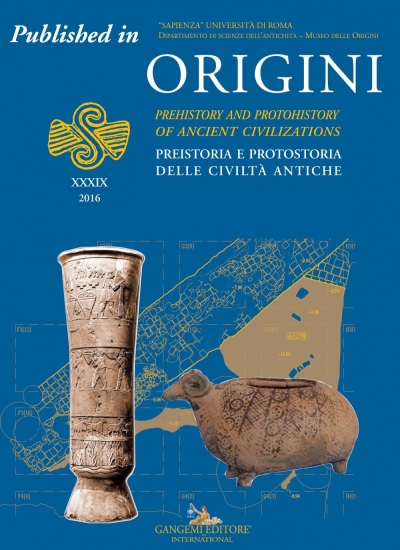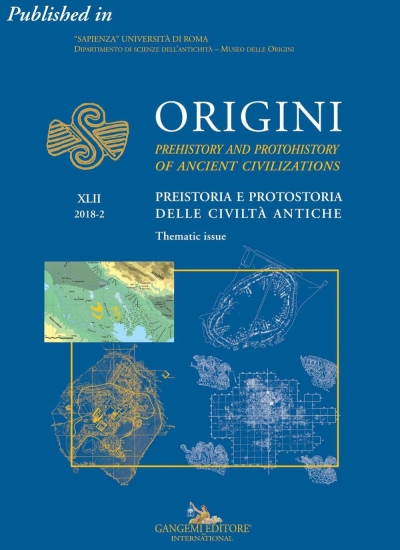“The king at the gate”. Monumental fortifications and the rise of local elites at Arslantepe at the end of the 2nd Millennium
Published in Origini n. XXXIX/2016. Rivista annuale del Dipartimento di Scienze dell’Antichità – “Sapienza” Università di Roma | Preistoria e protostoria delle civiltà antiche – Prehistory and protohistory of ancient civilizations
Autore:
Editore:
Anno:
2017
ISBN:
9788849248418
DRM:
Adobe (The downloaded file has the .acsm extension and is converted into the purchased format upon installation on your eReader)
Autore:
Editore:
Anno:
2017
ISBN:
9788849248418
DRM:
Adobe (The downloaded file has the .acsm extension and is converted into the purchased format upon installation on your eReader)
Description
This paper aims at presenting the results of recent investigations on the Early Iron Age at Arslantepe/Malatya (SE Turkey), which yielded important new data on the rise and collapse of a local power that used figurative representation at the town’s gate to express its authority. The 12th century BCE was one of the most relevant periods of transformation in the Syro-Anatolian region, which saw the decline of the Hittite Empire and the emergence of independent polities that re-elaborated the imperial tradition in original ways. The breakdown of the empire was not a generalized event, rather a process developing in an uneven temporal and geographic range. The Arslantepe case shows that the collapse was delayed, as it was contained by the rising of a local elite, which adopted strategies of territorial control and manifestation of power through the use of monumental buildings and sculptured reliefs. The archaeological evidence from Arslantepe will be presented and correlated with the Late Bronze Age epigraphic sources from Emar and the land of Aštata. These texts describe rituals illustrating the importance of city-gates as performance spaces in festivals involving the entire community and document the increasing financial support of the local kings. The festivals might have been also an instrument to establish or legitimate a stronger role of a previous “limited kingship” within the community after the Hittite conquest. The association of visual representations and rituals performed at the city-gates offer some reflections about the development of the Syro-Anatolian societies, as well as the role of the ruling class during the late-2nd millennium BCE.
Tags
By the same author
ORIGINI - XLI
Preistoria e Protostoria delle Civiltà Antiche - Prehistory and Protohistory of Ancient Civilizations
Preistoria e Protostoria delle Civiltà Antiche - Prehistory and Protohistory of Ancient Civilizations
29.99 €
39
-41
 ORIGINI - XLI
Preistoria e Protostoria delle Civiltà Antiche - Prehistory and Protohistory of Ancient Civilizations
ORIGINI - XLI
Preistoria e Protostoria delle Civiltà Antiche - Prehistory and Protohistory of Ancient Civilizations
Marcella Frangipane, Gangemi Editore
 ORIGINI - XLI
Preistoria e Protostoria delle Civiltà Antiche - Prehistory and Protohistory of Ancient Civilizations
ORIGINI - XLI
Preistoria e Protostoria delle Civiltà Antiche - Prehistory and Protohistory of Ancient CivilizationsMarcella Frangipane, Gangemi Editore
29,99 €
A “FLAME AND FROND” IVORY PLAQUE FROM THE NEO-HITTITE EXCAVATIONS AT ARSLANTEPE/MELID. REGIONALISMS AND COMMUNITIES IN IRON AGE ANATOLIA
Published in Origini n. XLI/2018. Rivista annuale del Dipartimento di Scienze dell’Antichità – “Sapienza” Università di Roma | Preistoria e protostoria delle civiltà antiche – Prehistory and protohistory of ancient civilizations
Published in Origini n. XLI/2018. Rivista annuale del Dipartimento di Scienze dell’Antichità – “Sapienza” Università di Roma | Preistoria e protostoria delle civiltà antiche – Prehistory and protohistory of ancient civilizations
6.99 €
39
-41
 A “FLAME AND FROND” IVORY PLAQUE FROM THE NEO-HITTITE EXCAVATIONS AT ARSLANTEPE/MELID. REGIONALISMS AND COMMUNITIES IN IRON AGE ANATOLIA
Published in Origini n. XLI/2018. Rivista annuale del Dipartimento di Scienze dell’Antichità – “Sapienza” Università di Roma | Preistoria e protostoria delle civiltà antiche – Prehistory and protohistory of ancient civilizations
A “FLAME AND FROND” IVORY PLAQUE FROM THE NEO-HITTITE EXCAVATIONS AT ARSLANTEPE/MELID. REGIONALISMS AND COMMUNITIES IN IRON AGE ANATOLIA
Published in Origini n. XLI/2018. Rivista annuale del Dipartimento di Scienze dell’Antichità – “Sapienza” Università di Roma | Preistoria e protostoria delle civiltà antiche – Prehistory and protohistory of ancient civilizations
Federico Manuelli, Gangemi Editore
 A “FLAME AND FROND” IVORY PLAQUE FROM THE NEO-HITTITE EXCAVATIONS AT ARSLANTEPE/MELID. REGIONALISMS AND COMMUNITIES IN IRON AGE ANATOLIA
Published in Origini n. XLI/2018. Rivista annuale del Dipartimento di Scienze dell’Antichità – “Sapienza” Università di Roma | Preistoria e protostoria delle civiltà antiche – Prehistory and protohistory of ancient civilizations
A “FLAME AND FROND” IVORY PLAQUE FROM THE NEO-HITTITE EXCAVATIONS AT ARSLANTEPE/MELID. REGIONALISMS AND COMMUNITIES IN IRON AGE ANATOLIA
Published in Origini n. XLI/2018. Rivista annuale del Dipartimento di Scienze dell’Antichità – “Sapienza” Università di Roma | Preistoria e protostoria delle civiltà antiche – Prehistory and protohistory of ancient civilizationsFederico Manuelli, Gangemi Editore
6,99 €
ORIGINI - XXXIX
Preistoria e protostoria delle civiltà antiche - Prehistory and protohistory of ancient civilizations
Preistoria e protostoria delle civiltà antiche - Prehistory and protohistory of ancient civilizations
Marcella Frangipane,
Giorgia Agresti,
Silvia Alaura,
Ebru Albayrak,
Mario Amore,
Magda Bordigoni,
Filippo Bozzo,
Giorgio Brocato,
Isabella Caneva,
Patrizia Costa,
Gian Maria Di Nocera,
Emilia Gallo,
Philip Jones,
Coskun Köysu,
Cristina Lemorini,
Federico Manuelli,
Francesco Marano,
Azzurra Mascelloni,
Naomi F. Miller,
Federico Moresi,
Lucia Mori,
Davide Nadali,
Marco Pacciarelli,
Fabio Parenti,
Giancarlo Pastura,
Claudia Pelosi,
Holly Pittman,
Elena Pizzo,
Andrea Polcaro,
Fabio Rossi,
Ulderico Santamaria,
Antonio Tagliacozzo,
Halil Tekin,
Flavia Venditti,
Daniela Zampetti,
Nadine Mine Yar
29.99 €
39
-41
 ORIGINI - XXXIX
Preistoria e protostoria delle civiltà antiche - Prehistory and protohistory of ancient civilizations
ORIGINI - XXXIX
Preistoria e protostoria delle civiltà antiche - Prehistory and protohistory of ancient civilizations
Marcella Frangipane, Gangemi Editore
 ORIGINI - XXXIX
Preistoria e protostoria delle civiltà antiche - Prehistory and protohistory of ancient civilizations
ORIGINI - XXXIX
Preistoria e protostoria delle civiltà antiche - Prehistory and protohistory of ancient civilizationsMarcella Frangipane, Gangemi Editore
29,99 €
“THE KING AT THE GATE”. MONUMENTAL FORTIFICATIONS AND THE RISE OF LOCAL ELITES AT ARSLANTEPE AT THE END OF THE 2ND MILLENNIUM
Published in Origini n. XXXIX/2016. Rivista annuale del Dipartimento di Scienze dell’Antichità – “Sapienza” Università di Roma | Preistoria e protostoria delle civiltà antiche – Prehistory and protohistory of ancient civilizations
Published in Origini n. XXXIX/2016. Rivista annuale del Dipartimento di Scienze dell’Antichità – “Sapienza” Università di Roma | Preistoria e protostoria delle civiltà antiche – Prehistory and protohistory of ancient civilizations
6.99 €
39
-41
 “THE KING AT THE GATE”. MONUMENTAL FORTIFICATIONS AND THE RISE OF LOCAL ELITES AT ARSLANTEPE AT THE END OF THE 2ND MILLENNIUM
Published in Origini n. XXXIX/2016. Rivista annuale del Dipartimento di Scienze dell’Antichità – “Sapienza” Università di Roma | Preistoria e protostoria delle civiltà antiche – Prehistory and protohistory of ancient civilizations
“THE KING AT THE GATE”. MONUMENTAL FORTIFICATIONS AND THE RISE OF LOCAL ELITES AT ARSLANTEPE AT THE END OF THE 2ND MILLENNIUM
Published in Origini n. XXXIX/2016. Rivista annuale del Dipartimento di Scienze dell’Antichità – “Sapienza” Università di Roma | Preistoria e protostoria delle civiltà antiche – Prehistory and protohistory of ancient civilizations
Federico Manuelli, Gangemi Editore
 “THE KING AT THE GATE”. MONUMENTAL FORTIFICATIONS AND THE RISE OF LOCAL ELITES AT ARSLANTEPE AT THE END OF THE 2ND MILLENNIUM
Published in Origini n. XXXIX/2016. Rivista annuale del Dipartimento di Scienze dell’Antichità – “Sapienza” Università di Roma | Preistoria e protostoria delle civiltà antiche – Prehistory and protohistory of ancient civilizations
“THE KING AT THE GATE”. MONUMENTAL FORTIFICATIONS AND THE RISE OF LOCAL ELITES AT ARSLANTEPE AT THE END OF THE 2ND MILLENNIUM
Published in Origini n. XXXIX/2016. Rivista annuale del Dipartimento di Scienze dell’Antichità – “Sapienza” Università di Roma | Preistoria e protostoria delle civiltà antiche – Prehistory and protohistory of ancient civilizationsFederico Manuelli, Gangemi Editore
6,99 €
ORIGINI - XLII
Preistoria e Protostoria delle Civiltà Antiche - Prehistory and Protohistory of Ancient Civilizations
Preistoria e Protostoria delle Civiltà Antiche - Prehistory and Protohistory of Ancient Civilizations
Marcella Frangipane,
Linda Manzanilla,
Guillermo Algaze,
Reinhard Bernbeck,
Pascal Butterlin,
Andrea Cardarelli,
Alberto Cazzella,
R. Alan Covey,
Terence N. D'Altroy,
Pierre de Miroschedji,
Gary M. Feinman,
Marcella Frangipane,
Maria Carmela Gatto,
Linda Manzanilla,
Dominique Michelet,
Lucia Mori,
Davide Nadali,
Linda M. Nicholas,
Hans J. Nissen,
Philippe Nondédéo,
Frances Pinnock,
Susan Pollock,
Giulia Recchia,
David Wengrow
34.99 €
39
-41
 ORIGINI - XLII
Preistoria e Protostoria delle Civiltà Antiche - Prehistory and Protohistory of Ancient Civilizations
ORIGINI - XLII
Preistoria e Protostoria delle Civiltà Antiche - Prehistory and Protohistory of Ancient Civilizations
Marcella Frangipane, Gangemi Editore
 ORIGINI - XLII
Preistoria e Protostoria delle Civiltà Antiche - Prehistory and Protohistory of Ancient Civilizations
ORIGINI - XLII
Preistoria e Protostoria delle Civiltà Antiche - Prehistory and Protohistory of Ancient CivilizationsMarcella Frangipane, Gangemi Editore
34,99 €
URBANISATION IN THE CENTRAL SAHARA IN GARAMANTIAN TIMES: A LOOK FROM THE SOUTH
Published in Origini n. XLII/2018. Rivista annuale del Dipartimento di Scienze dell’Antichità – “Sapienza” Università di Roma | Preistoria e protostoria delle civiltà antiche – Prehistory and protohistory of ancient civilizations
Published in Origini n. XLII/2018. Rivista annuale del Dipartimento di Scienze dell’Antichità – “Sapienza” Università di Roma | Preistoria e protostoria delle civiltà antiche – Prehistory and protohistory of ancient civilizations
6.99 €
39
-41
 URBANISATION IN THE CENTRAL SAHARA IN GARAMANTIAN TIMES: A LOOK FROM THE SOUTH
Published in Origini n. XLII/2018. Rivista annuale del Dipartimento di Scienze dell’Antichità – “Sapienza” Università di Roma | Preistoria e protostoria delle civiltà antiche – Prehistory and protohistory of ancient civilizations
URBANISATION IN THE CENTRAL SAHARA IN GARAMANTIAN TIMES: A LOOK FROM THE SOUTH
Published in Origini n. XLII/2018. Rivista annuale del Dipartimento di Scienze dell’Antichità – “Sapienza” Università di Roma | Preistoria e protostoria delle civiltà antiche – Prehistory and protohistory of ancient civilizations
Lucia Mori, Gangemi Editore
 URBANISATION IN THE CENTRAL SAHARA IN GARAMANTIAN TIMES: A LOOK FROM THE SOUTH
Published in Origini n. XLII/2018. Rivista annuale del Dipartimento di Scienze dell’Antichità – “Sapienza” Università di Roma | Preistoria e protostoria delle civiltà antiche – Prehistory and protohistory of ancient civilizations
URBANISATION IN THE CENTRAL SAHARA IN GARAMANTIAN TIMES: A LOOK FROM THE SOUTH
Published in Origini n. XLII/2018. Rivista annuale del Dipartimento di Scienze dell’Antichità – “Sapienza” Università di Roma | Preistoria e protostoria delle civiltà antiche – Prehistory and protohistory of ancient civilizationsLucia Mori, Gangemi Editore
6,99 €
ORIGINI - XXXIX
Preistoria e protostoria delle civiltà antiche - Prehistory and protohistory of ancient civilizations
Preistoria e protostoria delle civiltà antiche - Prehistory and protohistory of ancient civilizations
Marcella Frangipane,
Giorgia Agresti,
Silvia Alaura,
Ebru Albayrak,
Mario Amore,
Magda Bordigoni,
Filippo Bozzo,
Giorgio Brocato,
Isabella Caneva,
Patrizia Costa,
Gian Maria Di Nocera,
Emilia Gallo,
Philip Jones,
Coskun Köysu,
Cristina Lemorini,
Federico Manuelli,
Francesco Marano,
Azzurra Mascelloni,
Naomi F. Miller,
Federico Moresi,
Lucia Mori,
Davide Nadali,
Marco Pacciarelli,
Fabio Parenti,
Giancarlo Pastura,
Claudia Pelosi,
Holly Pittman,
Elena Pizzo,
Andrea Polcaro,
Fabio Rossi,
Ulderico Santamaria,
Antonio Tagliacozzo,
Halil Tekin,
Flavia Venditti,
Daniela Zampetti,
Nadine Mine Yar
29.99 €
39
-41
 ORIGINI - XXXIX
Preistoria e protostoria delle civiltà antiche - Prehistory and protohistory of ancient civilizations
ORIGINI - XXXIX
Preistoria e protostoria delle civiltà antiche - Prehistory and protohistory of ancient civilizations
Marcella Frangipane, Gangemi Editore
 ORIGINI - XXXIX
Preistoria e protostoria delle civiltà antiche - Prehistory and protohistory of ancient civilizations
ORIGINI - XXXIX
Preistoria e protostoria delle civiltà antiche - Prehistory and protohistory of ancient civilizationsMarcella Frangipane, Gangemi Editore
29,99 €
“THE KING AT THE GATE”. MONUMENTAL FORTIFICATIONS AND THE RISE OF LOCAL ELITES AT ARSLANTEPE AT THE END OF THE 2ND MILLENNIUM
Published in Origini n. XXXIX/2016. Rivista annuale del Dipartimento di Scienze dell’Antichità – “Sapienza” Università di Roma | Preistoria e protostoria delle civiltà antiche – Prehistory and protohistory of ancient civilizations
Published in Origini n. XXXIX/2016. Rivista annuale del Dipartimento di Scienze dell’Antichità – “Sapienza” Università di Roma | Preistoria e protostoria delle civiltà antiche – Prehistory and protohistory of ancient civilizations
6.99 €
39
-41
 “THE KING AT THE GATE”. MONUMENTAL FORTIFICATIONS AND THE RISE OF LOCAL ELITES AT ARSLANTEPE AT THE END OF THE 2ND MILLENNIUM
Published in Origini n. XXXIX/2016. Rivista annuale del Dipartimento di Scienze dell’Antichità – “Sapienza” Università di Roma | Preistoria e protostoria delle civiltà antiche – Prehistory and protohistory of ancient civilizations
“THE KING AT THE GATE”. MONUMENTAL FORTIFICATIONS AND THE RISE OF LOCAL ELITES AT ARSLANTEPE AT THE END OF THE 2ND MILLENNIUM
Published in Origini n. XXXIX/2016. Rivista annuale del Dipartimento di Scienze dell’Antichità – “Sapienza” Università di Roma | Preistoria e protostoria delle civiltà antiche – Prehistory and protohistory of ancient civilizations
Federico Manuelli, Gangemi Editore
 “THE KING AT THE GATE”. MONUMENTAL FORTIFICATIONS AND THE RISE OF LOCAL ELITES AT ARSLANTEPE AT THE END OF THE 2ND MILLENNIUM
Published in Origini n. XXXIX/2016. Rivista annuale del Dipartimento di Scienze dell’Antichità – “Sapienza” Università di Roma | Preistoria e protostoria delle civiltà antiche – Prehistory and protohistory of ancient civilizations
“THE KING AT THE GATE”. MONUMENTAL FORTIFICATIONS AND THE RISE OF LOCAL ELITES AT ARSLANTEPE AT THE END OF THE 2ND MILLENNIUM
Published in Origini n. XXXIX/2016. Rivista annuale del Dipartimento di Scienze dell’Antichità – “Sapienza” Università di Roma | Preistoria e protostoria delle civiltà antiche – Prehistory and protohistory of ancient civilizationsFederico Manuelli, Gangemi Editore
6,99 €


